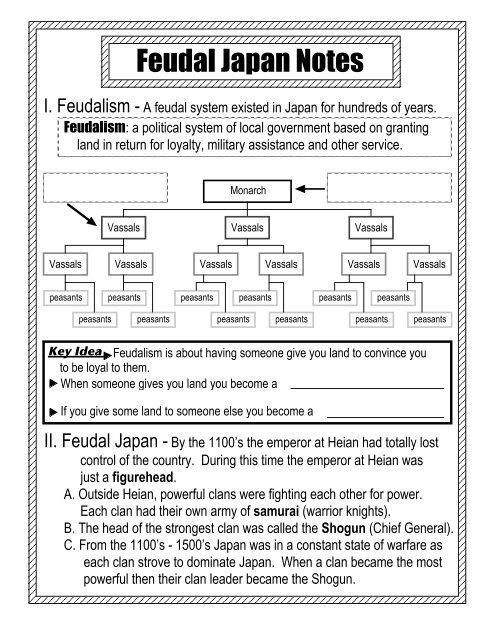You also want an ePaper? Increase the reach of your titles
YUMPU automatically turns print PDFs into web optimized ePapers that Google loves.
<strong>Feudal</strong> <strong>Japan</strong> <strong>Notes</strong><br />
I. <strong>Feudal</strong>ism - A feudal system existed in <strong>Japan</strong> for hundreds of years.<br />
<strong>Feudal</strong>ism: a political system of local government based on granting<br />
land in return for loyalty, military assistance and other service.<br />
Monarch<br />
Vassals<br />
Vassals<br />
Vassals<br />
Vassals Vassals Vassals Vassals Vassals Vassals<br />
peasants<br />
peasants<br />
peasants<br />
peasants<br />
peasants<br />
peasants<br />
peasants<br />
peasants<br />
peasants<br />
peasants<br />
peasants<br />
peasants<br />
Key Idea <strong>Feudal</strong>ism is about having someone give you land to convince you<br />
to be loyal to them.<br />
When someone gives you land you become a<br />
If you give some land to someone else you become a<br />
II. <strong>Feudal</strong> <strong>Japan</strong> - By the 1100’s the emperor at Heian had totally lost<br />
control of the country. During this time the emperor at Heian was<br />
just a figurehead.<br />
A. Outside Heian, powerful clans were fighting each other for power.<br />
Each clan had their own army of samurai (warrior knights).<br />
B. The head of the strongest clan was called the Shogun (Chief General).<br />
C. From the 1100’s - 1500’s <strong>Japan</strong> was in a constant state of warfare as<br />
each clan strove to dominate <strong>Japan</strong>. When a clan became the most<br />
powerful then their clan leader became the Shogun.
In <strong>Japan</strong>, the way of the warrior remained a<br />
Two <strong>Feudal</strong> Societies powerful force in society until 1854. In Europe,<br />
feudalism ended 400 years earlier. Why did feudalism<br />
die in Europe? For one thing, growing towns<br />
offered alternatives to people who did not want to<br />
function within the feudal system. Also, military<br />
technology changed in the 1300’s. Large Armies<br />
with new weapons - the longbow in the 1300’s and<br />
guns in the 1400’s - made mounted knights less<br />
effective in battle.<br />
Knights were often more interested in overseeing<br />
their land than in serving as warriors. Sometimes<br />
they refused to fight when asked to perform<br />
military service. When feudalism was strong, this<br />
would have resulted in a ceremony of public<br />
disgrace. But, after about 1400, kings began to rely<br />
on paid armies rather than asking knights to honor<br />
their feudal obligations.<br />
In <strong>Japan</strong>, the ruling Shoguns eventually<br />
forced samurai to become literate and to learn<br />
The <strong>Japan</strong>ese samurai warrior and the<br />
administrative skills. In Europe, however, most<br />
knight on this page face each other across 6,000<br />
knights didn’t learn these skills. Administrators in<br />
miles. Even so, the men are strikingly similar. Like<br />
European kingdoms were often clergy members.<br />
the knight, the samurai rides a horse and wears<br />
<strong>Feudal</strong>ism in <strong>Japan</strong> lasted longer than feudalism<br />
in Europe partly because samurai who were not<br />
armor. The samurai’s armor consists of lacquered<br />
steel plates sewn together with leather strips.<br />
warriors became government administrators. Also,<br />
Although earlier European knights had worn<br />
<strong>Japan</strong> sealed itself off from the West between 1635<br />
heavy chain mail shirts, this particular knight is<br />
and 1854, thus preserving its feudal society. Like in<br />
encased in plates of steel.<br />
Europe, <strong>Feudal</strong>ism arose in <strong>Japan</strong> to fill a need for<br />
Both men spent their lives preparing to<br />
government and protection. And just as in Europe,<br />
wage battle for their lords. When the samurai was<br />
<strong>Japan</strong>ese feudalism declined quickly when things<br />
a boy, he practiced with a long wooden sword and<br />
began to change.<br />
studied martial arts. At 15 he exchanged the<br />
wooden sword for a long metal one. The knight<br />
too, began his training young learning to fight as<br />
a paige and as a squire.<br />
The samurai practiced Buddhism and<br />
Shinto. The knight prayed to Jesus Christ. But both<br />
men followed a code of behavior that stressed loyalty<br />
to their lords and serving as examples of virtue to<br />
people of lower classes. Despite the miles and<br />
years that separate them, the warriors are alike in<br />
many ways. Both defended the fortresses and<br />
castles of their lord. Each was a member of a<br />
specially trained warrior class and provided<br />
protection to the people in feudal societies.

















